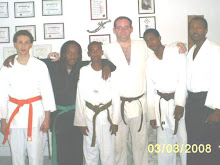 The very first principle of Aikido is to get off the line of attack, Tegatana No Kata gives us what we need to practice this principle at our own pace, at our own time, according to our own personal understanding levels. Accomplishing this "first" principle enables us to achieve the second principle of creating and continuing kuzushi, or off-balance, of the attacker.
The very first principle of Aikido is to get off the line of attack, Tegatana No Kata gives us what we need to practice this principle at our own pace, at our own time, according to our own personal understanding levels. Accomplishing this "first" principle enables us to achieve the second principle of creating and continuing kuzushi, or off-balance, of the attacker.This is the most basic practice of Aikido. If this can be accomplished then all of the techniques of Aikido appear without unnecessary force.
When confronted with a true attack, our natural reactions are to move or remain frozen to the spot (Fight or Flight). In our practice, we are training ourselves to "move" and to continue our motion in accordance with the attack until the threat is neutralized or projected safely away from us. To accomplish this we must stay just out of reach of our attacker, while maintaining ma-ai. We do this by moving our center (That means our entire being) off the line, this creates the  initial off balance by "not" being where our attacker "knows" we are. This "mental" off balance precedes the physical. Some effort is required to maintain this physical off balance by over extending the attackers reaction to the "mental" off balance and if we just continue to move with our attacker the "fall or throw" inevitably occurs.
initial off balance by "not" being where our attacker "knows" we are. This "mental" off balance precedes the physical. Some effort is required to maintain this physical off balance by over extending the attackers reaction to the "mental" off balance and if we just continue to move with our attacker the "fall or throw" inevitably occurs.
This will be the focus of the next class. I have observed many times the correct application of a technique during the nijusan kata but observed complete technique failure during randori no kata because of the attempt of a technique when control of the initial off balance is lost. Let's face it, no one is going to let us throw them down or throw themselves down for that matter. We must create an atmosphere where falling is the only option. initial off balance by "not" being where our attacker "knows" we are. This "mental" off balance precedes the physical. Some effort is required to maintain this physical off balance by over extending the attackers reaction to the "mental" off balance and if we just continue to move with our attacker the "fall or throw" inevitably occurs.
initial off balance by "not" being where our attacker "knows" we are. This "mental" off balance precedes the physical. Some effort is required to maintain this physical off balance by over extending the attackers reaction to the "mental" off balance and if we just continue to move with our attacker the "fall or throw" inevitably occurs.Everyone is invited to this class,
Ngakpa Sensei
Ngakpa Sensei
"OM MANI PEME HUNG"







No comments:
Post a Comment